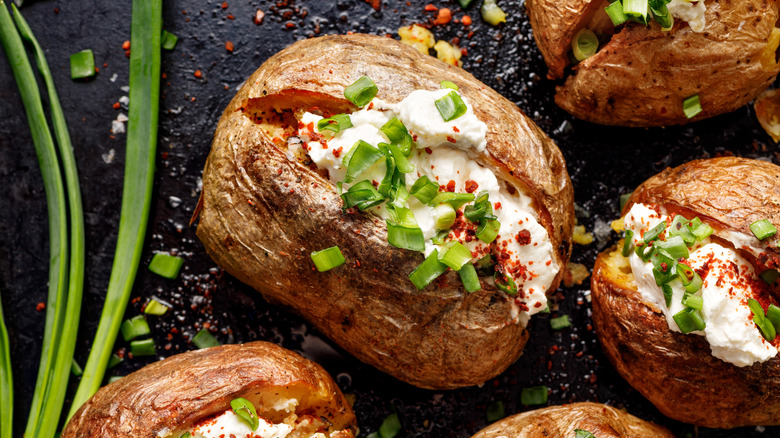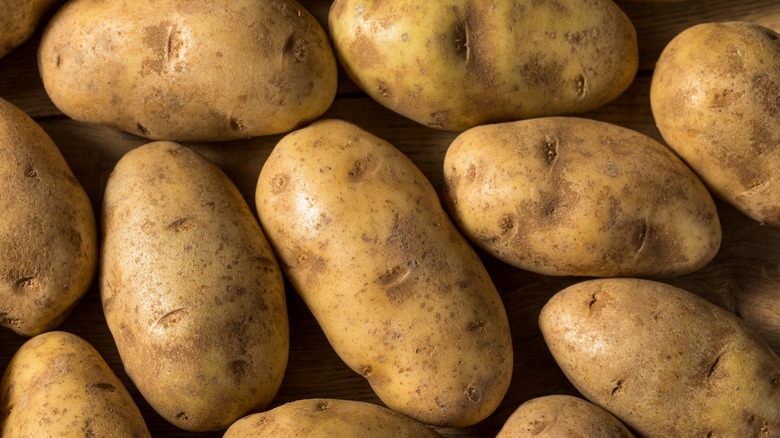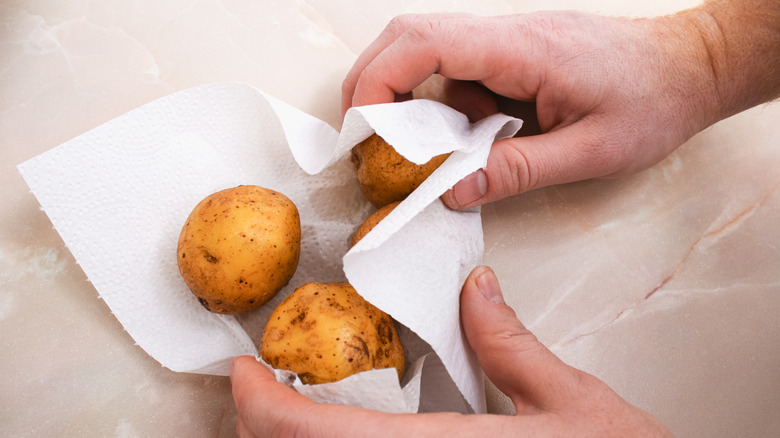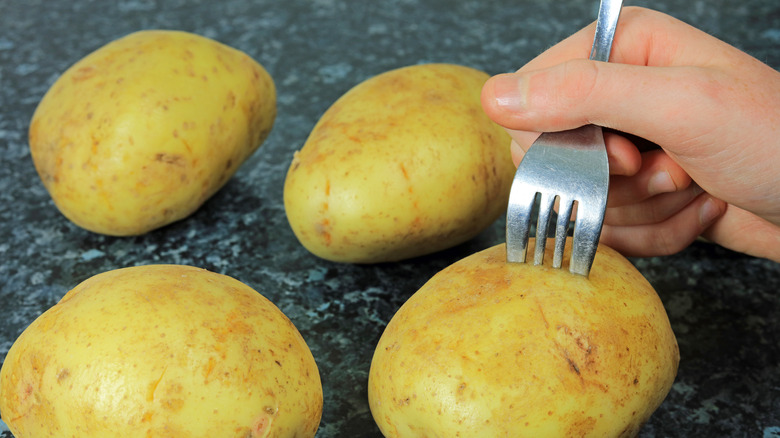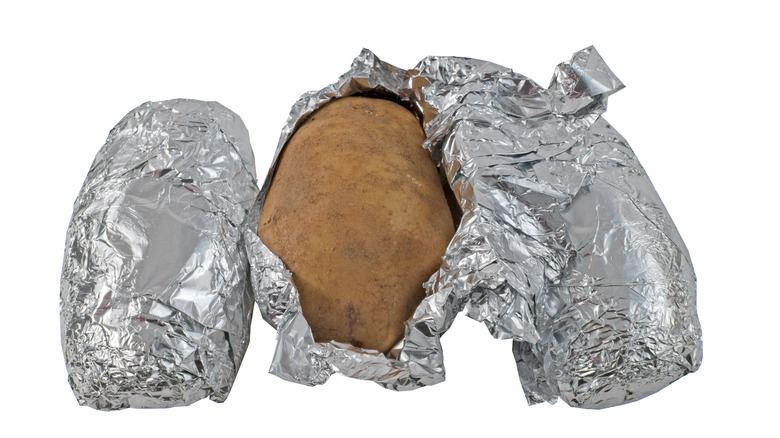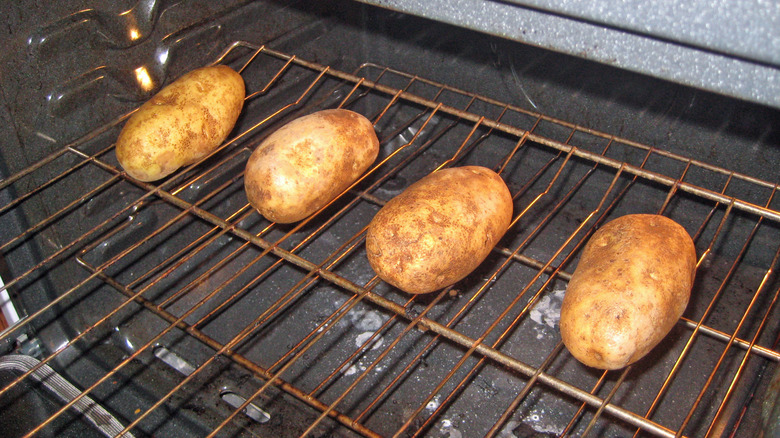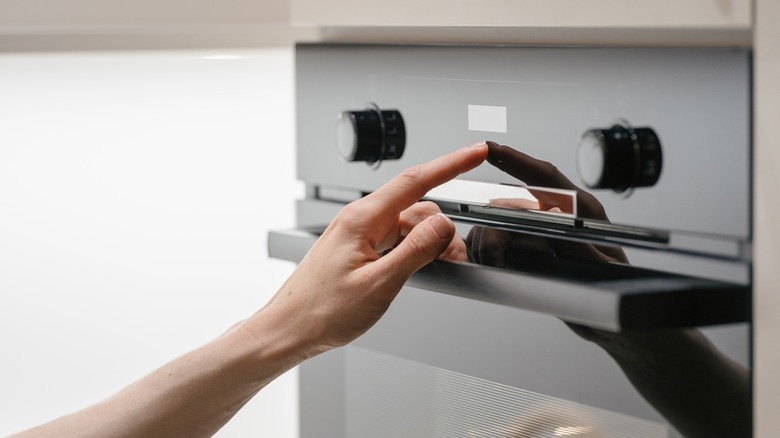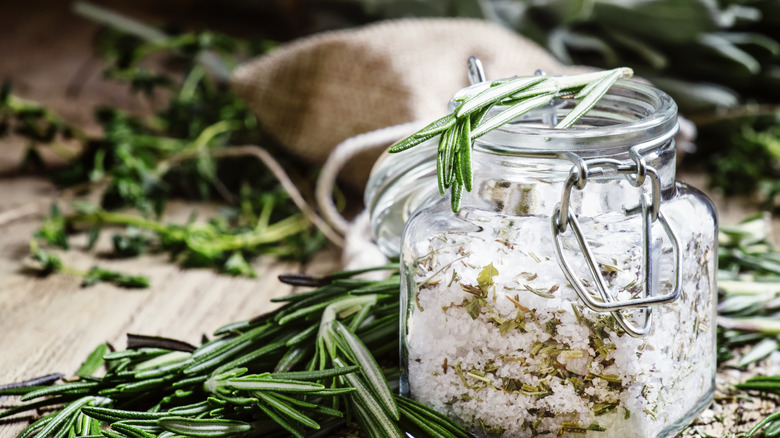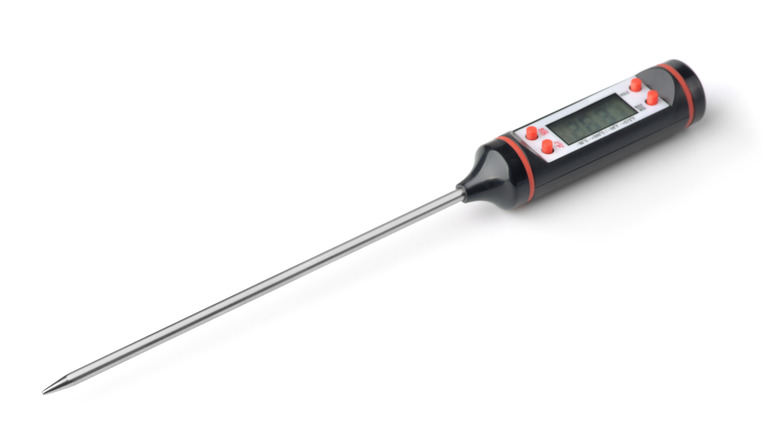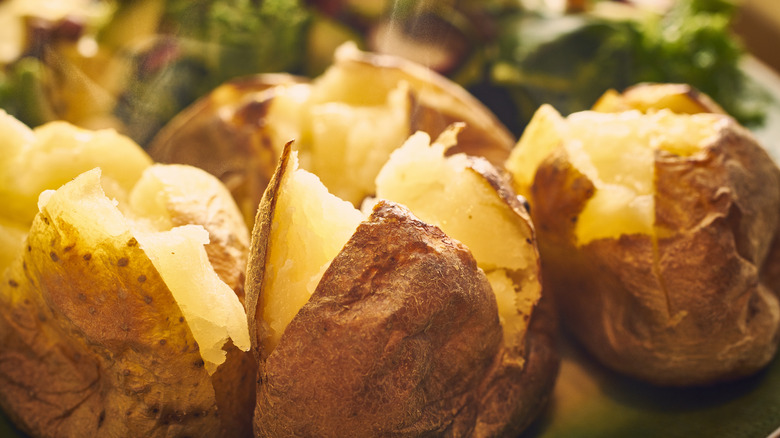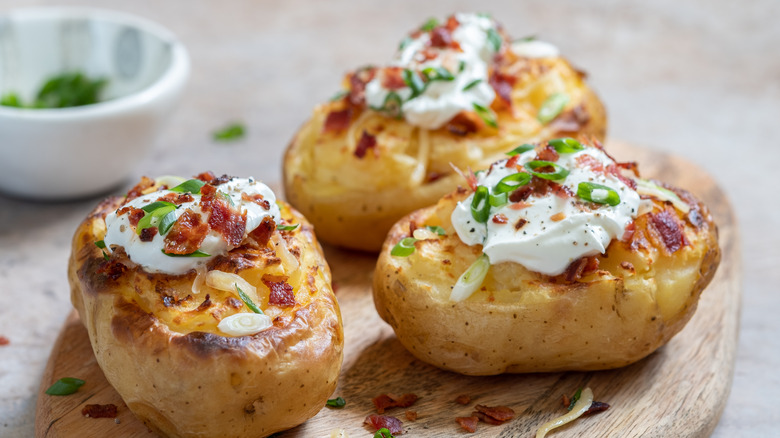10 Tips You Need For Delicious Baked Potatoes
Perfectly baked potatoes are crisp on the outside and pillowy soft in the center, ready for a kiss of salted butter, a sprinkling of chives, or even a spoonful of caviar. They can be served as a side dish with your favorite protein or smothered with hefty toppings for a full-blown meal. Baked potatoes are a simple and satisfying dish everyone can enjoy, from carnivores to vegans.
Potatoes have some notable health benefits, too. They are a great source of iron and zinc and boast high-quality protein with virtually no fat (via Healthline). According to the Mayo Clinic, one medium baked potato with its skin provides an excellent source of potassium and vitamins C and B6.
Baked potatoes are one of the most well-loved, versatile foods, and, generally speaking, cooking them in the oven is a simple task. But for many, the results often need improvement. Here are our top tips for achieving baked potato perfection.
Use the right type of potatoes
Russets rule the roost in the land of baked potatoes. Their thick skins and low-moisture, high-starch content allow them to bake up with a fluffy texture and crispy skin. Russets are relatively easy to find at most grocery stores, but if you need an alternative, go with Idaho.
When buying potatoes, look for ones with no bruises and unbroken skin. Avoid spuds that are growing eyes. This is a sure sign that the potatoes are past their peak and aging quickly. If you're baking potatoes for a crowd, choose ones of uniform shape and size so they cook more evenly.
The best way to keep potatoes fresh is to store them in a cool, dry place out of sunlight (but not out of sight) and in a well-ventilated container. You can use a cardboard box, paper bag, or even a laundry basket. And as convenient as it may be, don't store potatoes near onions. Onions produce high levels of ethylene gas which speeds up the ripening process, causing your potatoes to go bad quickly.
Dry the potatoes well
Even if your potatoes appear clean, it is always wise to scrub them under running water before baking to remove any dirt on the skin. It's a step you shouldn't skip — as long as you use the same amount of care when drying them. Always make sure to dry your potatoes before baking them because any moisture left on the skin will prevent your spuds from getting nice and crisp. Use paper towels or an absorbent dish towel to soak up any wet spots on the skin. If you put a wet potato in a hot oven to bake, there's a good chance its skin will turn out soft and limp. And no one likes soggy potato skin.
Pro tip: If you have the opportunity to plan ahead, wash and dry your potatoes in the morning, then leave them on the counter (out of direct sunlight) on a wire rack to air dry during the day. This will all but guarantee crispy potato skins are in your future.
Pierce the potato skins before baking
Anyone who has prepared mashed potatoes from scratch is aware that suds contain a lot of moisture. When an unpeeled potato is heated, the moisture is absorbed by starch granules and eventually becomes steam. As the steam pushes against the potato skin, the pressure can build up, causing the potato to explode. Now, this may not be a common occurrence, but it is definitely worth making sure disaster doesn't strike. After all, no one wants to clean up half-baked potato bits off the oven walls at dinnertime.
Luckily, the steps needed to prevent an exploding potato accident are quick and easy. All you need to do is use the tines of a fork to poke shallow holes through the skin of your unbaked potatoes. (You can also use the tip of a sharp paring knife.) We recommend evenly spaced holes over the potato in four to six places. Skipping these punctures likely won't result in a kitchen catastrophe, but why take the risk?
Skip the foil
Unless you plan on cooking your potatoes on an outdoor grill, keep that roll of aluminum foil in the kitchen drawer. Foil is not your friend when baking potatoes in the oven. It acts like a barrier, trapping steam inside. That's why Alton Brown skips the foil wrap to ensure optimal baked potato texture. According to Brown, "Unless you like limp, soggy, gummy baked potatoes, please stay away from the foil" (via Food Network).
The major pitfall of baking a foil-wrapped potato in the oven is that it will turn mushy. Too much moisture gets trapped inside, causing the potatoes to steam, not bake. This results in a dense, gluey interior and wet, shriveled skin — a far cry from the light, creamy texture and crisp outer skin we all strive for.
And despite common belief, wrapping potatoes in foil doesn't shorten the baking time. As the Idaho Potato Commission explains, "since the foil itself has to be heated before the potato begins to bake, cooking times increase slightly."
Bake the potatoes directly on the oven rack
We know it's tempting to bake your potatoes on a baking tray. But if you do, there's a good chance that the parts of the potatoes that touch the tray will bake up hard and possibly soggy. If your baking tray is made of aluminum, a conductive material, it can heat up quickly and leave dark burned spots on the potato bottoms.
For restaurant-quality spuds with gorgeous, crisp skins, bake your potatoes directly on the oven rack. (A wire rack placed over a baking tray works well, too.) This method allows the heat to surround the potatoes while baking, ensuring even cooking all around. It is the best way to achieve that glorious contrast between crackly skin and a delicate, fluffy center. If you're concerned about drippings falling onto the oven floor, place a sheet of aluminum foil on the rack below to catch any drips.
Choose the right oven temperature
Low and slow is the game-changing tip for extraordinary baked potatoes if you have the time (and patience). Case in point: the super slow-cooked loaded baked potato courtesy of Tasting Table recipe developer Jennine Rye. She bakes her potatoes in the oven for 3 hours at 350 degrees Fahrenheit. Rye says, "Baking potatoes slowly for a longer time results in a far superior baked potato. It gives them a delicious, thick, and crispy skin with super fluffy insides."
But hey, we get it. Not everyone can devote 3 hours to baking potatoes. If that's the case, you can set the oven temperature between 425 to 450 degrees Fahrenheit. Your potatoes will be delightfully plump and crisp in about an hour. Just don't go any higher than 500 degrees Fahrenheit. With the heat cranked that high, you're likely to end up with baked potatoes that over-browned and slightly charred with a burnt taste.
Flavor the skins
Potato skins have more nutrients than the insides of the potatoes, and about half of a medium-sized potato's total fiber content is found in its exterior casing (via the Idaho Potato Commission). But as healthy as they are, they're pretty bland and tasteless without a bit of help. So why not take a moment to add some pizazz to the skin?
We happen to love Ina Garten's trick for adding flavor to baked potato skins. When she bakes potatoes, she uses an herby mixture to achieve a tasty — and lovely — crust. Garten starts by rubbing the potatoes in olive oil, then rolling them in a blend of rosemary, thyme, lemon, and sea salt mixed in a food processor (via YouTube). It's a brilliant mix of ingredients to achieve a gorgeous, full-flavored crust.
Hoping for something simpler? After you wash and scrub your potatoes, give them a 5-second dunk in salted water. This is a quick way to season the skin, adding tremendous flavor and contributing to crisper skin while using mere seconds of your time.
Don't overbake the potatoes
According to the Idaho Potato Commission, a potato is perfectly baked when it reaches an internal temperature of 210 degrees Fahrenheit. At this temperature, the potatoes' white starch granules will have absorbed as much moisture as possible, swelling and bursting into soft clumps. At any lower temperature, not enough moisture gets absorbed, and the potato's interior remains dense and gummy. For the most accurate temperature reading, stick your thermometer halfway down the thickest part of the potato.
Can't find a thermometer? Don't fret. There are some visual cues you can use. If the potato skin looks wrinkled, remove it from the oven immediately, as this is a sure sign it's becoming overcooked. Test for doneness by gently squeezing the middle of the potato (use a dry dish towel or oven mitts as it will be very hot). If it feels soft and yields to your touch, it's ready.
Serve the potatoes hot
It's essential to slice open potatoes immediately after baking them. This allows the steam to come out, ensuring the inside stays light and fluffy. If you allow the baked potatoes to sit uncut, moisture will build up inside, resulting in dense, gummy logs of starch.
Use a serrated knife to score the potato as soon as it comes out of the oven. Make two cuts, lengthwise and crosswise, then place your fingers on each end of the potato. Gently squeeze in and up until the potato opens.
Or, if you're into foodie hacks, try Martha Stewart's trick for opening up baked potatoes. Using a thick, dry dish towel, pick up the potato (be careful, it's hot) and firmly slam it down on the counter with enough force to tear open the skin. The potato will burst open and reveal a billowy, steaming interior. The potato may lose its shape, but that's to be expected. Simply push it back together to serve.
If you're wondering why you don't have to wait that long for baked potatoes at restaurants, the answer is they're likely being kept in a warming drawer. Don't have one in your home kitchen? Not to worry. Keep your potatoes warm in an oven set to its lowest temperature (around 200 degrees Fahrenheit) or a slow cooker set to the warm setting.
Get your toppings right
Let's be honest. A naked baked potato is rather dull and tasteless. So why not let your creativity shine while adding enticing flavors and aromas to this versatile dish?
There is a whole slew of toppings that go great on a piping-hot baked potato. From compound butter and caramelized onions to pulled pork and baked beans, toppings can turn a plain baked potato into a drool-inducing culinary wonder. A freshly cut, steaming baked potato is just waiting to be topped. Load it up with classic toppings like chili, butter, and chives. Or, if you're feeling ambitious, try our ultimate twice-baked potatoes recipe. Crisp potato skins are filled with creamy mashed potatoes blended with sour cream, cheddar cheese, crisp bacon, and green onions, then garnished with more cheese, bacon, and green onions. The whole concoction is warmed in the oven and served hot.
A word to the wise: Don't make the mistake of putting cold toppings on a hot potato — it's a total buzzkill, trust us. It's best to remove toppings from the refrigerator when you start prepping your potatoes.
